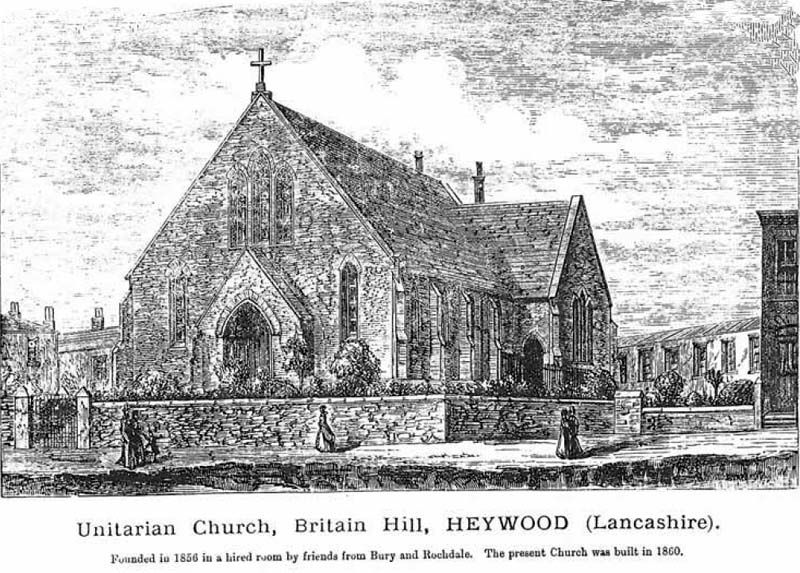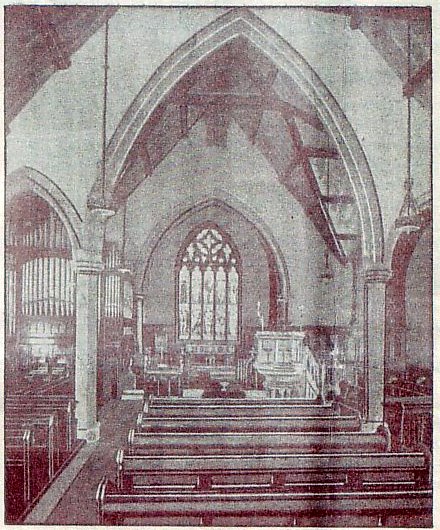|
|
We provide a focus for liberal religious worship and reflection and a centre of fellowship for people of religious sentiment. |
||||||||||||||||||||
|
Bury Unitarian Church |
|||||||||||||||||||||
|
|
|||||||||||||||||||||
|
|
|
Unitarianism in Heywood - 1856-1956 By Herbert Holt
Unitarianism first started in Heywood in the year 1856. There was probably only one family of Unitarians resident in the town, that being the Nuttall family of Broadfield Farm. They had a fairly large family and used to go regularly to the Unitarian Church at Bury, taking their meals with them. The Nuttalls were instrumental in bringing missionaries into the town. The late William Wild was interested and used to travel to Bury to attend the Unitarian Church. A small room in Oak Street, on the old market ground, now the Memorial Gardens, was rented at Is. 6d. a night. The first service was in June, 1856. The preacher was the Rev. John Wright, B.A., who had a congregation of eight persons, and some of these had grave doubts whether they were doing right in being there. On the second Sunday Mr. Benjamin Glover, a lay preacher residing in Bury, preached. He was so enamored of the work that he acted as honorary pastor of the new congregation. After twelve months it was felt that a larger room was necessary and a more suitable one was obtained at Mossfield. Here the pioneers remained for three years. The first services held at Mossfield, in September, 1857, were conducted by the Rev. William Gaskell, husband of Mrs. Gaskell, the author of Cranford. A Sunday school was started, and over fifty scholars were entered on the books on the opening day. The first person to put in an appearance was James Partington, a young man who, on hearing that the Unitarians were about to open a Sunday school, resolved to join at once and, in order that he might not be late, got there so early that he had to stand for a considerable time before the door was opened. The connection which James Partington formed on that day continued; he was to serve both school and church in many offices. Mr. Robert was appointed superintendent of the school and Mr. William Healey, Sen., secretary. The school and church at Mossfield fast outgrew the accommodation and it was felt that something must be done; so a movement was started to build a church. Mr. Thomas Wrigley of Bury offered £100 towards a building fund. After Hind Hill had been refused to a Unitarian body, Britain Hill was chosen as a suitable site. It contained 7,589 square yards and was leased at three farthings a yard on a yearly rent of £23 lls. 4d. At that time there were few houses in the neighbourhood and the question arose in the minds of some why so much ground should be wanted. But subsequent events have shown the wisdom of the undertaking. Most of the surplus land was very quickly let for building plots at double the rent at which the Trustees had leased it, so the Chapel soon became almost free from ground rent. Britain Hill was a rough piece of land, and much hard work had to be done before it was fit to build upon. This work was undertaken by members of the church. Among the old pioneers were such men as Messrs. Chadwick, Firth, Healey, Jerrard, Nuttall, Rhodes, Whitworth, Wild and others. The descendants of many of the pioneers are still with us, but we have room for more.Thomas Wrigley, Esq., added another £50 to the £100 he had promised. John Grundy, Esq., of Summerseat gave £100. It was thought that £1,000 would be required for the building, but owing to the failure of the builder and other causes it cost an additional £700. The congregation raised about £90; £384 was received from Bury; £211 from Manchester; £52 from Rochdale; £67 from Liverpool; £20 from Pilsworth and £14 from Bolton. Also £104 was given in the opening collection.
The Jubilee Celebrations and Reunion of Past and Present Worshippers took place on June 23rd and 24th, 1906. On the 23rd there was a tea, then a public meeting in the chapel, under the chairmanship of Alderman Sutcliffe Firth, J.P. On the Sunday the Rev. Douglas Walmsley preached morning and evening. In the afternoon the Band gave a Musical Service; the chairman was Mr. S. A. Rhodes. On Saturday, November 19th, 1910, a reunion and soiree was held, being 50 years since the present chapel was opened. Alderman William Healey, J.P., C.C., was chairman. Addresses were given by the Rev, John Fox, Mr. T. Harwood, J.P., Mr. David Healey, J.P., Mr. William Wild, J.P., and the Rev. T. B. Evans, M.A. The Sunday services were conducted by the Rev. T. B. Evans (morning) and the Rev. J. C. Odgers, B.A. (evening). Weber's Jubilee Cantata was given by the choir and scholars in the afternoon. The school extension was opened on February 28th, 1925, by Alderman David Healey, J.P.; Councillor Walter Duckworth was chairman. The Provincial Assembly again visited Britain Hill on June 23rd, 1926. One June 20th and 21st, 1931, the Seventy-Fifth Celebrations were held. The Rev. T. B. Evans, M.A., preached morning and evening. The afternoon preacher was the Rev. F. Munford, B.A., who will, we hope, also take part in the forthcoming Centenary Celebrations. Many members of the church have taken their part in local government affairs. Eight members who have been President of the Church have also been Mayor of the Borough, three of whom, Alderman W. D. Healey, J .P., Mr. James Hunt and Mr. Herbert Holt, are regular members of the present congregation. Fifteen Mayoral Sundays have been held in the church. Several other members have served on the local Council and the Board of Guardians. The church has been served by several ministers since 1913; viz.: the Revs. Joseph Worthington (1914-16), F. Munford, B.A. (1917-1927), J. W. Lee (1928-1933), G. S. Whitby, M.A., B.D. (1934-1938), F. Sokell (19391945), W. H. Payne (1946-1951) and F. J. Hamblin (1951-). The limited space prevents us giving details of the activities of all the ministers who have had charge of Britain Hill, or of superintendents and others who have taken up work in both church and Sunday school, or of those helped sustain such good causes outside our walls as the Inskip League of Friendship and the Blind Society, besides other charitable, cultural and sporting activities. We are not in the happy position, as regards numbers and finance, that we have been in the past; but we do: hope that our people will realise what efforts and hardships had to be overcome before we were enabled to worship in our own way, and show that our forefathers laboured not in vain. ____________________ A fire in 1968 and other difficulties led to the congregation deciding to close the Church and amalgamate with the Bank Street and Chesham congregations Click here for additional information: |
INTRODUCTORY BOOKLET: |
||||||||||||||||||
|
Bury Unitarian Church Tel: 0161 761 3785
|
|
||||||||||||||||||||
|
|
|||||||||||||||||||||
|
|
|
Back to top | |||||||||||||||||||




